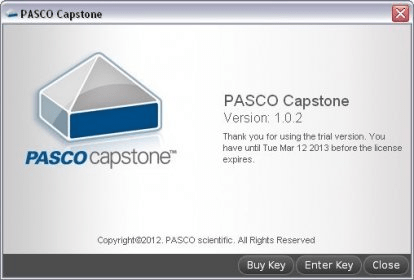

- #PASCO CAPSTONE PROGRAMMED IN WHAT LANGUAGE FOR FREE#
- #PASCO CAPSTONE PROGRAMMED IN WHAT LANGUAGE PROFESSIONAL#
- #PASCO CAPSTONE PROGRAMMED IN WHAT LANGUAGE FREE#
#PASCO CAPSTONE PROGRAMMED IN WHAT LANGUAGE FREE#
The Free Flight Operational Enhancements Program (FFOEP) identified nine enhancements. A study of 112 air-carrier accidents during a three-year period in Alaska indicated a likely 38% safety improvement from modern technology. For this reason, the Alaskan Region supported efforts to enhance the NAS and become a test bed for new technology.

Many accidents could be eliminated through improved situational awareness for both pilots and controllers. Capstone outlined the process and scope for upgrading the operating infrastructure with airports, weather products, communications, and GPS-driven systems.Ī major objective was to improve safety in Alaska while offering efficiencies to operators. Within Alaska, Capstone linked several initiatives to coordinate between the FAA, community, and industry. Several Alaskan avionics installers reported customers seeking to acquire GPS equipment defer investing as they waited for Flight 2000. As an example, the additional aviation weather observing systems the NTSB called for in Alaska relies on the Flight 2000 Flight Information System element to provide the information developed via data link to the pilot.Ī key objective of Flight 2000 had been to accelerate implementation and use of modern technology however, uncertainties surrounding that program actually slowed the transition. A few additional "technology-driven" initiatives supportive of Flight 2000 are recommended in a March 1995 National Transportation Safety Board (NTSB) Alaska Safety Study, inextricably linked to the earlier proposal. Within the Alaskan Region, Flight 2000 served as the "capstone" for many additional initiatives, providing a common umbrella for planning, coordination, focus, and direction with regard to development of the future National Airspace System (NAS).
#PASCO CAPSTONE PROGRAMMED IN WHAT LANGUAGE FOR FREE#
The revised approach was documented in the "Joint Government/Industry Roadmap for Free Flight Operational Enhancements". The proposal was not well received by all segments of the aviation industry, and the industry's RTCA (Radio Technical Commission for Aeronautics) Select Committee on Free Flight endorsed a revised approach that included most Flight 2000 program activities. This proposal envisioned rapid deployment and field demonstration of advanced avionics capabilities leading toward implementation of free flight. In early 1997, the US Federal Aviation Administration (FAA) began developing a proposal entitled "Flight 2000". History Flight 2000 proposal and program development

#PASCO CAPSTONE PROGRAMMED IN WHAT LANGUAGE PROFESSIONAL#
More than one-third of the annual air commuter accidents in the US occurred in Alaska, and more than ten percent of the professional pilots working there would not survive a thirty-year career. The harsh environment of Alaska contributed to averages of one aircraft accident every other day, and one accident-related fatality every nine days. However, the vital infrastructure supporting aviation fell short of the standards commonly expected or encountered elsewhere in the US. With a very limited highway and railroad infrastructure, aviation emerged as the essential – and in most locations the only – transportation system.

In the late 1990s, one out of every 58 people in the state was a pilot, with six airplanes for every ten pilots.


 0 kommentar(er)
0 kommentar(er)
